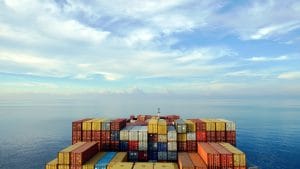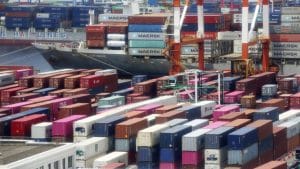Yet another crisis for Indian exporters
Summary
The higher transport costs that exporters face in shipping goods to net importing countries tend to reduce the comparative advantages of exporters in those countries.
There is a crisis again looming for Indian exporters. And this time is not just the shortage of containers.
The global supply chains are under stress. There is a shortage of most essential products- from intermediates to chemicals to coal to semi-conductors leading to what ‘The Economist‘in its recent lead article called ‘the shortage economy’. The crisis has now shifted to large container carrying vessels. There are large-scale traffic jams at very many of the major ports in the globe with vessels not getting berthing space.
More than 80 percent of world trade volume is transported by ships; 70 percent of such trade is in containers. The global fleet that carries seaborne trade involves dry bulk ships, container ships and oil tankers. These vessels operate either on fixed schedules like in the case of container ships. Or on flexible timing (‘ocean taxis’) like in the case of bulk cargo. Dry bulk ships account for half the seaborne trade and transport ore, coal, grains.
Also Read: COVID-19: Government removes export curbs on all diagnostic kits, reagents
Insightful research has been done in this regard by Brancaccio, G, Kalouptsidi, M. and Papageorgiou, T. (Geography, Transportation, and Endogenous Trade Costs. Econometrica, 88: 657-691). Though in the context of bulk cargo it is applicable equally to other categories of trade. The study shows that world trade is greatly imbalanced – countries are either net importers or net exporters. There is thus an inherent imbalance in the availability of vessels and containers.
The research of Brancaccio et all goes on to show that consequently at any point of time nearly 42 percent of vessels are travelling without cargo-dramatically adding to costs. They point out ‘Shipping lines demand more to travel towards a destination with low exports, to compensate for the difficulty of finding a new cargo originating from that destination. All else equal, the prospect of having a return trip without cargo or lesser cargo leads to higher prices.
The higher transport costs that exporters face in shipping goods to net importing countries tend to reduce the comparative advantages of exporters in those countries. Vice versa, relatively cheaper transport provides the exporters in net importing countries with some cost advantage.
Also Read: Exports rise by 22.63% to $33.79 billion in Sept; trade deficit up $22.59 billion
We need to juxtapose this with the fact that China, the ‘factory of the world’ has been witnessing a slowdown. A slow-down in Chinese imports affects their exports and also has a huge domino effect. This coupled along with the piling up of containers in Chinese ports triggered the container crisis last year.
Its impact continues to be felt now. US ports are experiencing severe congestion. This again is a direct result of the trade imbalance. The increasing emphasis on outsourcing imports leading to imports far exceeding exports.
Incidentally and not surprisingly, while trade has suffered, the shipping lines have been doing very well. As a Reuters report points out, the seven largest publicly traded ocean carriers — including companies such as Maersk, COSCO and Hapag-Lloyd — reported more than $23 billion in profits in the first half of this year, compared with just $1 billion in the same period last year.
All this is severely impacting Indian exports at a time when they have been doing well. The merchandise export in September 2021 was $33.34 billion an increase of over 21 percent over the corresponding figures in September last year. This is the peak festive season market in the USA and Europe. Indian exporters have to factor in a dramatic increase in shipping charges which have upset all calculations.
The Container Availability Index (CAx) is used to monitor inbound and outbound volumes of containers for every port globally. In the context of India, CAx indicates that the inbound containers are at an all-time high since 2019 by about 4X at the Chennai port (and similarly other ports in India). What this means is an all-time high in the imbalance of inbound and outbound containers at Indian ports. Costs have shot up.
The sea freight from Nhava Sheva, India’s largest major port to the US in October 2020 for a TEU (twenty equivalent unit) container was $2,200 and $3,000 for a larger container, the forty-equivalent unit (FEU). Today it is US $10,000 and $13,000 respectively-an increase of 300 + percent. Similarly, the freight for a TEU to Europe was $700 and for an FEU $1200; today it is $7,000 and $10,000, an increase of more than 700 percent. The situation is the same across all major ports and across all shipping lines.
The government has recently announced a Rs 56,027 crore package for the export sector-this is over and above the Rs 12,454 crore announced under the RoDTEP scheme and Rs 6,946 crore announced under the RoSCTL. This is substantial but will not cover the dramatic and sudden increase in costs of transportation. Ideally, the government should step in to announce a freight support scheme. Export of empties should be stopped for the time being. Steps also should be taken to review the position of all detained, seized or abandoned containers and take steps to empty them. It is estimated that there are more than 15,000 containers strewn across the various ports of India. The Federation of Indian Exporters (FIEO) has sought urgent governmental intervention. The need for manufacturing containers in India has again been reinforced.
This crisis is expected to last till mid-2022. If India is to achieve the ambitious export target of $400 billion the Government will need to step in fast to provide a helping hand to the exporters.

Elon Musk forms several ‘X Holdings’ companies to fund potential Twitter buyout
3 Mins Read
Thursday’s filing dispelled some doubts, though Musk still has work to do. He and his advisers will spend the coming days vetting potential investors for the equity portion of his offer, according to people familiar with the matter









 Listen to the Article
Listen to the Article  Daily Newsletter
Daily Newsletter













